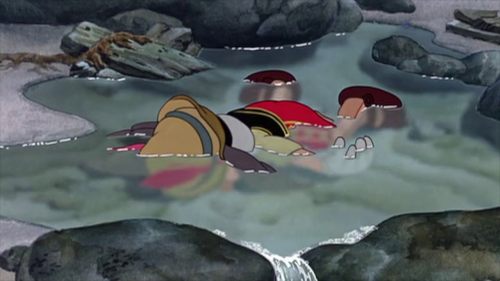PINOCCHIO At 80: Let Your Conscience Be Your Guide
Pinocchio, the timeless tale about a marionette who dreams of becoming a real boy, was only Walt Disney’s second film after Snow White and the Seven Dwarves. Right from the opening, this is a Disney film willing to push boundaries and take chances in a big way in terms of its narrative, tone and visuals. At its core, Pinocchio is a very simple and structured morality play about choosing the correct path and being truthful, unselfish and brave. However, it’s also a grand animated story that has scarred kids for generations and is fearlessly presented as a dark fairytale with some mind-altering horror elements.
Based on the Italian children’s novel by Carlo Collodi, Pinocchio feels like a fable right from the beginning. The woodworker Gepetto has built a marionette, made out of wood, but the doll wishes he could be a real boy. All the detail on Gepetto’s workshop is absolutely stellar, telling you so much about who Gepetto is and how melancholy his life feels with just images. The Blue Fairy coming in (her animation is particularly immaculate, and has this exquisite, ethereal beauty) perfectly brings up the fairy-tale tone but also sets up what’s at stake. Pinocchio needs to earn his soul and adhere to the teachings of the Blue Fairy in order to become a real boy. In this moment alone, the film already has allusions to existentialism (Pinocchio starts questioning everything as soon as he becomes alive) and the difference between right and wrong and good and evil.
The film gets progressively darker from there. It begins as soon as Pinocchio steps out into the real world and gets introduced to sleazy characters like Honest John and Gideon. Pinocchio starts seeing that not everyone is a purely altruistic figure like Gepetto or Jiminy Cricket. He learns that the world does have corrupt entities who will stop at nothing to take him on a darker path. Pinocchio will always be a film for children, but it nevertheless does not shy away from real world darkness.
This is particularly true when it comes to the idea of being kidnapped. Pinocchio gets abducted and they don’t sugarcoat that plot point at all. Honest John and Gideon pull him from his destination and flat out sell him for money to Stromboli, the owner of a traveling circus. Stromboli is first depicted as a fun person but later reveals to Pinocchio how cruel he is going to be (he threatens the poor puppet by threatening to chop him up once he is useless).
Even with its disturbing elements and adult sensibilities (the introduction of vices like drinking into a children’s films still seems boundary pushing), Pinocchio manages to have a grand fairy-tale like conclusion with a battle that's as spectacular as it is emotionally satisfying. The values that the Blue Fairy instructs Pinocchio to follow are paid off with him learning about the real world, learning that he’s going to have to choose which path he wants to be on, and ultimately following his conscience. He’s seen the best and worst of this world and as a result grown as a character. He is able to transcend his marionette body and earn his status as a real boy. Pinocchio’s lessons never feel didactic or preachy, which greatly helps it stand the test of time. If you haven’t seen it yet or haven’t revisited it in a long time, the film looks breathtaking in high definition thanks to Disney+.



